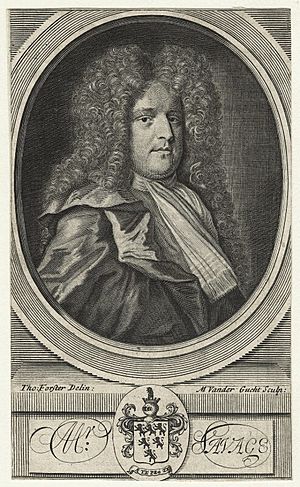John Savage (author) facts for kids
Quick facts for kids The Reverend John Savage |
|
|---|---|
| Rector of Clothall | |

Portrait engraved by Michael Vandergucht, after Thomas Forster (1702)
|
|
| Personal details | |
| Born | 1673 Hertfordshire |
| Died | 24 March 1747 (aged 72–73) Clothall, Hertfordshire |
| Denomination | Anglican |
| Alma mater | Emmanuel College, Cantab. Christ Church, Oxon. |
| Coat of arms | |
John Savage (born 1673, died 1747) was an English clergyman and writer. He was a member of the Anglican Church, which is the main church in England. He wrote many books and translated others.
Contents
John Savage's Life and Education
John Savage was born in 1673 in Hertfordshire, England. When he was 14, in 1687, he became a King's Scholar at Westminster School. This meant he was a talented student chosen to receive a special education.
After Westminster, he went to Emmanuel College, Cambridge in 1691. He earned his first degree, a Bachelor of Arts (B.A.), in 1694. He then got his Master of Arts (M.A.) in 1698. Later, in 1707, he earned two more advanced degrees from Christ Church, Oxford: a Bachelor of Divinity (B.D.) and a Doctor of Divinity (D.D.).
Travel and Church Work
After finishing his studies at Cambridge, John Savage spent eight years traveling. He explored almost every country in Europe with James Cecil, 5th Earl of Salisbury.
When they returned, the Earl of Salisbury made Savage his chaplain. A chaplain is a minister who serves a private household or institution. In 1701, the Earl also gave him a church job, called a "living," in Bigrave, Hertfordshire. This meant he became the rector, or head priest, of that church.
In 1708, he moved to a better church job in Clothall, also in Hertfordshire. He stayed there until he died. In 1732, he also became a lecturer at St. George's, Hanover Square in London.
Personality and Popularity
People who knew John Savage described him in different ways. One person, Cole, said he was "a stately man, rather corpulent." Another, Bishop Newton, called him "a lively, pleasant, facetious old man." This means he was seen as cheerful and funny.
He was also part of a famous social club in Royston. A former member of this club, Sir John Hynde Cotton, said Savage was "a very jolly convivial priest." This means he enjoyed good company and social gatherings.
John Savage cared a lot about his old school, Westminster. In 1750, the students there put up a white marble tablet in his honor. This shows how much they liked him. The Earl of Salisbury also remembered Savage by putting his name on the first stone of a building at Christ Church, Oxford, in 1705.
Later Life and Death
John Savage passed away in Clothall on March 24, 1747. He was about 73 years old. His death was caused by a fall from scaffolding. This scaffolding was set up for a trial in Westminster Hall.
A picture of him, made by Michael Vandergucht from a painting by Thomas Forster, was put at the beginning of his book, History of Germany.
John Savage's Writings
John Savage was a busy writer and translator. He published many works during his lifetime.
- History Books: In 1701, he published a shorter version of Richard Knolles and Paul Rycaut's Turkish History. He also wrote the first part of A Compleat History of Germany in 1702. He oversaw the rest of this large history project. He also helped edit and continue Bernard Connor's History of Poland (1698).
- Other Works: He put together A Collection of Letters of the Ancients in 1703. He also published two books of sermons (religious speeches) in 1704. In 1708, he wrote a poem for a collection of verses from Oxford.
- Translations: John Savage was very interested in books from other countries.
- He helped translate the works of Paul Scarron and Lucian.
- From French, he translated Memoirs of the Transactions in Savoy during this War (1697).
- From Spanish, he translated Antonio de Guevara's Letters (1697) and Balthasar Gracian's Oráculo Manual y Arte de Prudencia (1702).
- From Italian, he translated Moscheni's Brutes turned Criticks (1695), which was a collection of satirical letters.
- From Latin, he translated speeches by Gerhard Noodt (1708).
Family Connections
It is thought that William Savage, who was the Master of Emmanuel College, was related to John Savage. Another person named John Savage, who also went to Emmanuel College, was a rector in Morcot, Rutland, and the headmaster of Uppingham School.

